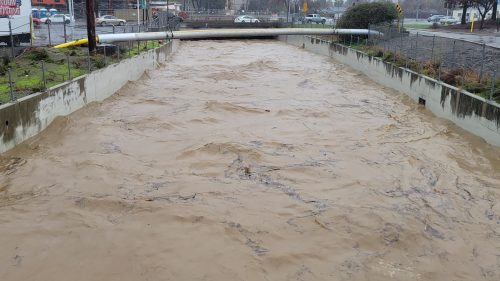The Bay Area is under a flood watch as rains are expected to continue throughout Northern California on Wednesday and this weekend, just after a soggy end to 2022.
State water officials at the California Department of Water Resources (DWR) say they are cautiously optimistic that this could replenish some of the state’s heavily depleted water reservoirs; but after four years of drought, heavy rains of this frequency and magnitude are pose a threat to property, natural resources and human life.
The National Weather Service noted that the storm, which will bring extreme wind and anywhere from 2 to 10 inches of rain around the Bay Area, will likely result in the loss of human life.
Under Gov. Gavin Newsom’s latest water supply strategy released in August, a myriad of California agencies are bracing for the state’s precipitation to swing more severely between drought and flood in the near future as the Western region of the country experiences a rapidly changing climate.
Deputy Director of Flood Management and Dam Safety for DWR, Gary Lippner, said that the state-federal Flood Operations Center is closely monitoring weather conditions to inform local partner agencies about elevated river and creek levels. He added that it’s a multi-agency partnership across the federal and state level to minimize downstream flooding and provide resources to overwhelmed local agencies.
Lippner said that in the event of the state utilizing its 1,600-miles worth of flood mitigation levees and weirs, the system has enough capacity to handle the anticipated forcasted showers this week.
“That flood system is designed to take pressure off the mainstream rivers of the San Joaquin and the Sacramento river,” said Lippner. “There is a fair amount of capacity in the system, certainly enough to handle the anticipated, forecasted flows for this week.”
Lippner said Californians should pay close attention to alerts and warnings from the National Weather Service and their local and county emergency service agencies.
On the one hand, extreme rain is boosting California’s snowpack – on Tuesday, DWR’s snow survey team determined that parts of the Sierra Nevada have snow depths 177 percent of average for this time of year. But the same storms are bringing flooding to other parts of the state, said Karla Nemeth, director of DWR.
“This is a prime example of the threat of extreme flooding during a prolonged drought as California experiences more swings between wet and dry periods brought on by our changing climate,” Nemeth said.
Michael Anderson, state climatologist for DWR, said that when looking at the bigger atmospheric patterns, the region will likely be in a transition period from the winter’s fading La Niña conditions to neutral conditions within the next few months, lending an increased probability of extreme weather.
“It’s sad to see with those higher [atmospheric river] scales, more hazards are introduced as the events become more extreme,” Anderson said. “But there’s a lot to storms beyond just the rain.”
Drought Manager of DWR Jeanine Jones said that the state needs above-average precipitation throughout the rest of its wet season in order to reach 100 percent of average runoff.
“We are overcoming a deficit in soil moisture,” Jones said. “We lose runoff until things get very wet, and we start getting good inflows into reservoirs and groundwater basins. But we do have deficit conditions in these basins from our prior dry years.”


When do they start giving us electric cars to prevent these ‘swings from drought to flood’. When we didn’t have rain they talked only about drought, know that we have some rain they talk about ‘swings’. Maybe these talk like this to get money from the feds.
These are the same Clown’s that labeled CO2 (Plants gotta have it) a pollutant. These fools will do ANYTHING for money and control.
I’m cautiously optimistic water is wet.
“State water officials” = clowns
This is the “new normal” or the “great reset” or whatever you want to call it. No matter what happens, it is a problem. Not enough rain? That’s a problem and will result in additional taxes, fines, and restrictions. Too much rain? That’s a problem and will result in additional taxes, fines, and restrictions.
They have to preserve their jobs which includes issuing warnings. In the meantime they lower the dams water so they don’t overflow.
Still running into the Ocean…. rather than being captured with a retention process… You know…. the type that Intelligent State Management would have put in place a few Yrs Ago… NOT a Govt. to be Proud Of..